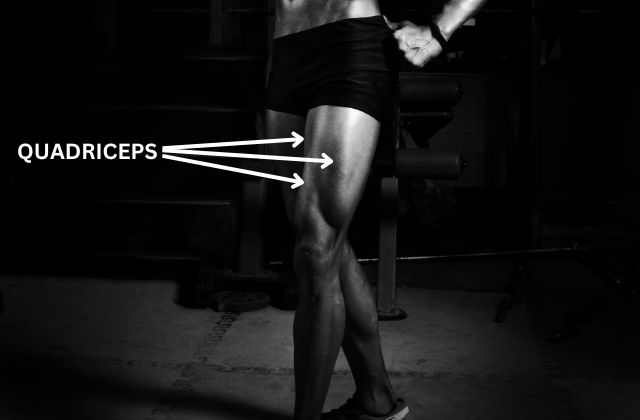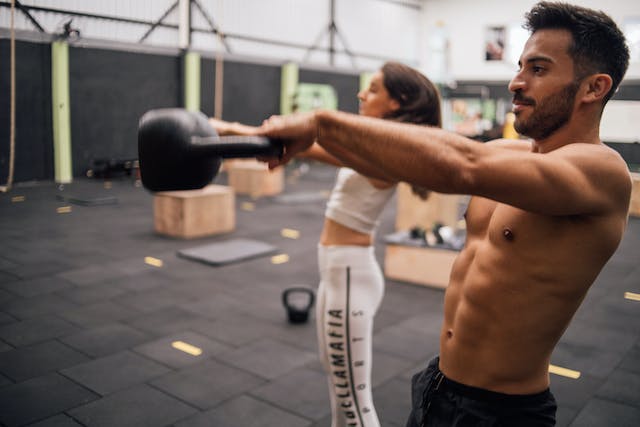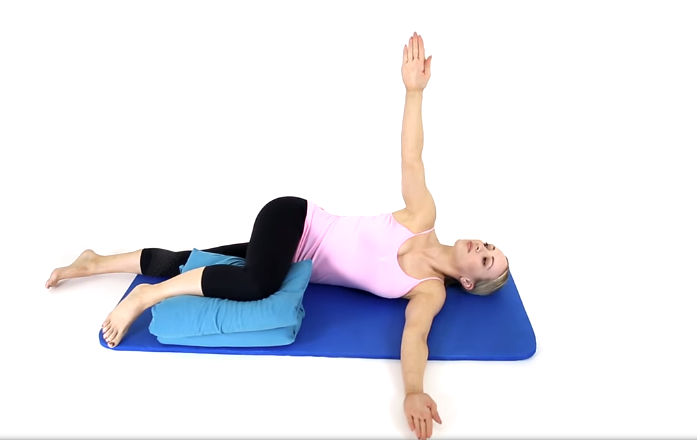If you are looking for a powerful exercise for the muscles of the lower body that does not require much equipment and at the same time can be done anywhere in the house, the backyard or the gym, there is no doubt that the Dumbbell Overhead Squats is one of the exercises that can make a difference at the level of your leg muscles and help to build a massive physique.
When you incorporate this exercise into your training routine, you will get many benefits, including developing your performance and stimulating your muscles to work, and this reflects positively on performing other exercises with high efficiency.
In this post we will get very close to the dumbbell overhead squat so that we will learn about the dynamics of its work and How can the greatest benefit be achieved, and for this we will learn about the mistakes and tips of professionals to improve performance, and we will also learn about the best variations.
Let’s continue together!
What is dumbbell overhead squats
Dumbbell Overhead Squat is a variant of a squat exercise, or it can be said that it is an advanced exercise for a squat exercise, which is done by doing a squat while keeping your arms holding a dumbbell above the head, and this exercise is relied upon to stimulate the leg muscles to grow and gain strength.
It is one of the compound exercises that occupy more than one joint and targets a group of muscles. It is also one of the exercises that puts the quadriceps muscles, the glutes, as well as the shoulder muscles (so that they in turn remain under the weight pressure throughout the exercise) in front of new challenges and help you move your fitness level to advanced ranks.
- Mechanics : Compound
- Utility : Power
- Force : Push
The targeted muscles during dumbbell overhead squat exercise
The Dumbbell Overhead squat exercise occupies more than one joint (hip joint, knee joint) and targets a group of muscles, including quadriceps, glutes, calves (soleus), adductors when squatting with knees out to the sides, then the calves.
Targeted muscle:
- Quadriceps: While doing squats, you stretch the thigh muscles well and then contract them again when you stand and push the weight up, and the available range of motion plays a major role in extending the muscles on a wider range.

Synergist:
- Glutes: the muscles of the buttocks or (glutes) work while extending the muscles of the hips back when you squat, and when you focus on squeezing them well, they are highly targeted, but in a secondary way.
- Adductors: Also, the adductors muscles are among the muscles that have a share of pressure, and the more you go with your knees and toes out during the squat, the more likely they will be targeted.
- Calfs (Soleus): Also, the soleus are located in the outer side of the leg and they work when bending the knee and pushing it forward a little. The Soleus is under the weight pressure, but in a secondary way.
Stabilizers:
- Hamstrings
- Gastrocnemius
Overhead squats muscle activation
How to perform a dumbbell overhead squat like a pro
Dumbbell Overhead Squat is an easy exercise and can be done professionally after a few attempts, so it is important that you learn the correct technique and form to control the movement path, as well as control the weight and pressure on your muscles well, for this we will work to make sure that you will get a good and successful exercise . And all you have to do is follow the following steps and work on applying the advice of professionals.
How to do a dumbbell overhead squat step by step:
- First, choose dumbbells with a weight that matches your fitness level, can be controlled, and safer.
- Stand with your feet wide than shoulder-width apart, keeping your toes pointed little outward if you want to squeeze your quadriceps more.
- Hold dumbbells with an overhand grip so that your palms are facing the ceiling.
- At this point, you should have dumbbells in front of your chest and ready to start the exercise.
- Raise dumbbells above your head, extend your arms well and combine the shoulders and keep your elbows locked out.
- Then start doing squats, lower slowly and keep your back straight and tighten your core well.
- As you are on your way to squatting, keep pushing your hips back and maintaining a clean form.
- Continue lowering until your thighs are parallel to the floor, then make a slight pause there to squeeze your muscles and burn them well.
- Explode from your heels and press the weight up and press the muscles of the thighs and return to the previous position again, make a slight pause there and then start the squat again.
Training Program
- Beginners : 3 sets / 8 – 10 reps / 60 sec rest
- Intermediate : 4 sets / 10 – 12 reps / 60 sec rest
- Advanced : 5 sets / 12 – 15 reps / 60 sec rest
Overhead squat performance : learn from specialists
Professional advice to improve your performance:
The most important thing with squatting exercises is maintaining proper form and applying a safe technique to do the exercise, so there are some things that you must deal with in order to improve performance, first of all is the weight. Try to start with a light weight that can be dealt with easily and does not force you to do the momentum a lot. .
During the Dumbbell Overhead squat exercise, try to keep the weight above your head with straight arms throughout the exercise.
You must practice keeping the weight and pelvis perpendicular to your heels because the heels are the point of strength available to you, so you should not let the pressure of the weight fall on your knee joints or move your arms back in a way Excessive this can also put some tension on the back muscles and you can get injured.
Also, with regard to the knees, you must keep your knees above your feet at all times, and your knee must point in the same direction as your toes in order to avoid any kind of tension that may affect your knees or expose you to injury.
Dumbbell Overhead squat : 5 common mistakes
Making mistakes is always one of the reasons for exposure to injuries or not getting satisfactory results because mistakes reduce the quality of the exercise and you do not get a good training for your muscles, so here are some common mistakes that you should avoid while doing a dumbbell overhead squat exercise.
You may be allowing your knees to go inward while squatting.
This mistake is common and often occurs when the position of your knees is not stable from the ground up, that is, your knees are not above your feet or are looking in the opposite direction of the toes. This mistake can hinder proper form and can put strong pressure on the knee joints and can lead to injury.
Make sure to keep your knees above your feet and in the same direction as your toes when you squat.
Hold a dumbbell with a weak grip.
This is also one of the common mistakes made by beginners. This mistake occurs as a result of lack of sufficient experience or when your grip is not correct.
This mistake also hinders the availability of correct form and can distract you and you will not be able to focus on the target muscles so that you remain preoccupied with how to deal with dumbbells. .
So try to hold the dumbbells with two well-tight fists. When lifting the dumbbell with a straight arm above the head, try to keep the dumbbell above the wrist and the wrist in turn is above the forearm, and the latter is supported by your arms and shoulders. I think it is clear that you should not put weight on your wrist.
Lowering too quickly.
Also, this mistake reduces the quality of the exercise because the muscles do not respond well when performing a rapid decline and do not keep them under enough pressure to exhaust them, and this can lead to a loss of balance and you will not be able to adopt a clean form and an ideal performance.
So keep calm and go down slowly enough to keep your muscles tense during the repetitions and in order to raise the quality of the exercise and get good results as well.
You arch your back.
If you arch your back during the exercises, your back may be severely affected and it may have negative repercussions in the future, not to mention the high probability of injury. There is no exercise that forces you to arch your back.
Therefore, you must practice keeping your back straight throughout the exercise, and do not bend too much forward, especially when you are carrying a weight above your head.
This may hinder your movement, and you will not be able to nappy properly, and may put extra pressure on your knees.
Going with weights that are beyond your physical fitness.
This is also a common mistake among beginners. Do not try to impress yourself with your supernatural abilities because you will expose yourself to injury because your muscles are still not accustomed to the weights and pressure of exercise and can be damaged or grow in a weak way.
So try to start with light weights and weights can be added gradually in line with the improvement of your fitness.
The benefits of overhead squats
- Improve Flexibility and Mobility The Dumbbell Overhead Squat exercise requires good handling of movement and flexibility whether at the level of the shoulders, hips or ankles, and when you seriously incorporate this exercise into your training routine, these skills will improve.
- It increases strength and explosiveness. Most compound exercises have an effective role in increasing muscle strength because a group of muscles interact with the exercise and work among themselves to control the pressure of the exercise, and thus strengthen these muscles collectively to improve the entire lower body fitness.
- Improve balance and coordination, when you carry a weight on your head and squating, this makes you cautious and try to stay on your path and stay balanced as much as possible, and with the passage of time you begin to improve balance and good coordination occurs between the upper body muscles with the lower muscles.
- Burning calories and building lean muscle mass, the Dumbbell Overhead Squat exercise helps you gain muscle effectively and increases the rate of burning calories, and the body continues to burn calories even after the sessions are over.
Know more about the effects and benefits
Any variations of dumbbell overhead squats ?
Of course, there are strong variables for the Dumbbell Overhead Squat exercise, which can be relied upon due to its effectiveness, and it will definitely put your muscles in front of different movements, and thus it will increase your muscles from work, and this also increases your fitness level and stimulates it to develop.
One arm dumbbell overhead squat.
This is the first variable that you can rely on in your training, so that you can do a set of dumbbell overhead squats using your hands together, then the next set can be replaced by relying on one arm, that is, you will carry a dumbbell with one straight arm above the head and the exercise steps will remain the same.
This exercise increases the development of balance, flexibility and mobility, and puts the muscles under tension throughout the exercise and makes sure that you do the same repetitions with each arm.
Dumbbell Overhead Squat pulse:
This is also one of the advanced exercises. It is really one of the secrets of building muscle strength and endurance, as well as stimulating them to grow, as well as improving your performance with the rest of the exercises and developing the fitness of the muscles of the lower part of the body completely. It is really a fun and wonderfully variable exercise.
This exercise is done by making some changes to the exercise. The steps will remain the same as we mentioned above, but the change you make is as follows:
You will normally lower down like a regular squat.
When you reach a good depth, instead of raising your body completely, try to do small pulses (squats), that is, go down and up in a range between standing and fully squating.
Do 3 or 4 repetitions, then squeeze your muscles and return to the first position, then repeat and so on.
Dumbbell Overhead Squat Jump:
This is another variant. It is an advanced type of squat, and it can develop your fitness well and is reliable. It can be a strong addition to your lower body muscle training routine so that it is more challenging for the muscles, tests your fitness, increases muscle fatigue, and helps you develop some skills such as (mobility, balance, flexibility).
As for the exercise steps, they remain the same as I mentioned previously, but the difference is:
When returning from the depth, try to explode from your heels and make a short jump on top of each repetition, then go back to squatting again, and while returning from the depth, press your muscles again and do a short jump, and so on.
FAQ
How many reps and sets should I do for dumbbell overhead squats?
In fact, this depends on your goals and physical fitness, but if you are a beginner and want to develop your fitness first, try to do 3 to 4 groups and 8 to 12 repetitions, and go with light weights at first, then add weights gradually.
What weight should I use for dumbbell overhead squats?
When it comes to weights, this also depends on your previous experience with carrying weights or your level of fitness. You can go with light weights and try different weights until you find the weight that exhausts your muscles and at the same time is safe.
Are there any precautions I should take when performing dumbbell overhead squats?
Yes, it is necessary to use a decent form and go according to your fitness level, in case you suffer from previous injuries in the shoulder joint or back, just avoid doing dumbbell overhead squats until you regain your fitness and recover completely.
Related posts
Shrimp squat guide for massive quads
Elevated sumo squat for lower body strength



